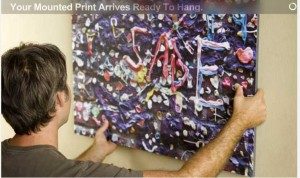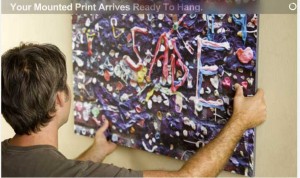Today, there are a number of digital alchemists who promise to turn your digital photos not into gold, per-se, but into a range of exotic material like aluminum, bamboo, glass or acryllic. In short, they promise to turn your photos into eye-popping pieces of wall art. And unlike the alchemists of old, these digital alchemists aren’t frauds.

What is Personal Wall Art?
There’s no hard-and-fast definition for what constitutes a piece of photographic wall art. For our purposes, we’re talking about using your own personal photograph and having it printed onto a unique material, such as canvas, glass, mirror, acrylic, aluminum, or bamboo. In general, these prints are large in size (upwards of 20-inches wide or larger) and are meant to be hung on the mantle or prominently displayed on a wall. These can be ordered online, using photos you’ve snapped on your own. Portrait studios, wedding and other professional photographers are also offering the option to have their images (of you) turned into wall art.
Why Would You Want That?
Well, for one, it looks unique. Slapping a photo into a frame and a frame onto a wall is well-honored tradition – and we have nothing against it – but sometimes it’s nice to do things differently. Whether you’re passionate about your photography or passionate about a particular picture (say of your family at their happiest), turning your photo into a piece of wall art delivers dramatic pop to any room. Depending on the material you choose, you can achieve a range of styles to suit your temperament: from a refined print on canvas to a sparkling, ultra-modern print on metal.
What Do You Need to Make Photo Wall Art?
Two things. First, you’ll need a high-resolution digital photo, the higher resolution (i.e. the larger the file size) the better. The services that produce wall art can tell you if your photo file is large enough to make a good print, so don’t worry if you’re not sure about the resolution of your photograph. Second, you’ll need a spot to hang it. Sounds obvious, but you’ll need to put a bit of thought into this as you don’t want to expose your piece of art to direct sunlight for prolonged periods of time, lest it fade. In general, wall art will resist fading longer than a plain old photo print, but given the investment it’s better to minimize the amount of sun-bathing it does.
There is an exception to this, however, and that’s photos printed onto glass. In this case, you may want to have light pass through it to provide a kind of natural back-lighting effect. Photos on glass can be framed and hung on a wall of course, but smaller sized photos can be mounted in a stand on a counter or mantle to let the less pass through. These smaller glass prints are less expensive, so even if some fading does occur, it’s not a huge expense to replace them over time.
While the sun does pose fading concerns (as it does for any photo print) many wall art materials are far more robust than photo paper. Metal prints tend to be scratch and water resistant, so they can be hung in places (like bathrooms) with high humidity or within reach of pawing hands.
Photo credit: Print Wizards
What Materials Can You Print To?
The short answer is almost anything you can imagine. Some of the more exotic surfaces include aluminum, glass, acrylic, and mirrors. You can also print to tapestries, Kirei boards, even wallpaper!
One thing to keep in mind when evaluating your choices is the difference between printing and mounting. Some printers will produce a photo print on paper and then mount, or adhere, that print to a surface like bamboo. They may call it a “bamboo print” but it’s really a photo print stuck on a bamboo surface. Mounted prints can look very attractive, but they look more like traditional photo prints and don’t have the unique characteristics of photos printed directly to a surface.
Don’t Forget Print Styles
You not only have a range of materials to print to, but you can choose from various styles as well. Canvas photo prints are very popular but you need not simply print your photo directly to a canvas – it can be reproduced to give it the look of a water color or brush-stroked painting. You can have it produced in full color, black and white or sepia-toned.
As far as size goes, your only limits are your photo file and your budget. Personalized photo wall art can be produced in some very large sizes – like 40 x 60-inches.
What Does Photo Wall Art Cost?
Cost typically rests on three factors: the kind of materials used, the size of your print and framing options. Of course, it’s going to cost more to print a photo on an exotic material like aluminum than it is to print the same sized photo on paper.
Framing is another consideration: some wall art products can be mounted directly to your wall, others, like glass-based products, may require a frame to be displayed securely. Frames add to the final cost.
Many online wall art printers won’t list pricing, or make it a bit difficult to discover what the final price is without first uploading an image. This is more common for those looking for exotic prints, as those are often produced by professional labs or commercial printers who do most of their business with other businesses, not consumers. Prices for canvas-based wall art is more readily available.
If we take a 20 x 20 photo, you can expect to pay above $120 for an acrylic print, upwards of $70 for an aluminum print, $90 for canvas, and closer to $200 for that photo on a mirror (prices don’t include shipping or framing options, so they’re on the lower-end of the spectrum).
What You Need to Look For When Ordering
There are two important factors to research in advance of choosing a wall art provider. First, is whether there is a warranty or some form of guarantee attached to the product: either against fading or damage. Photo wall art can be quite expensive and it’s nice to know your provider will stand behind the work. The second thing to verify is whether it will arrive fully assembled and ready to hang, or whether you’ll have to do any work. Most services will deliver wall prints that are ready-to-hang, but it’s best to ensure you know what the final product looks like so you’re not stuck trying to frame a huge piece of aluminum.


